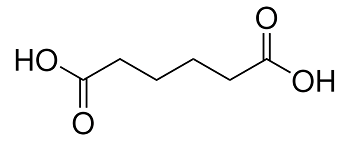Adipic Acid

Product Description
Adipic acid, also known as hexanedioic acid, is a chemical compound with a wide range of applications, particularly in the production of nylon.
Product:
Adipic Acid
CAS:
124-04-9
Synonym:
Hexanedioic Acid; 1,4-Butanedicarboxylic acid
Structure:

Typical Characteristics
Appearance
White crystalline solid
Boiling point
338 °C
Density
1.360 g/cm3
Flash Point
196 °C
Melting point
151-154 °C
Molecular Weight
146.14
Odor
Odorless
Purity
99%
Uses, Applications & Markets
Key applications
get a quote



Adipic Acid used in many
industry applications
Adipic acid is a chemical compound with various industrial applications. Here are some of its uses:
- Production of Nylon: Adipic acid is a key intermediate in the production of nylon 6,6, a widely used synthetic polymer. It reacts with hexamethylenediamine to form nylon 6,6, which is used in the manufacture of fibers, plastics, and engineering materials.
- Food Additive: It is used as a food additive (E number E355) to impart a tart flavor to food products. Adipic acid is commonly found in carbonated beverages, gelatin desserts, and baking powders.
- Adhesive Manufacturing: Adipic acid is used in the production of various types of adhesives, including epoxy resins, polyurethanes, and polyester adhesives.
- Plasticizers: It can be used as a plasticizer in polymer formulations to improve flexibility, impact resistance, and processability of plastics and elastomers.
- Textile Treatment: Adipic acid is sometimes used in the textile industry as a finishing agent to improve dye uptake and enhance the colorfastness of fabrics.
- Pharmaceuticals: It serves as an intermediate in the synthesis of various pharmaceuticals and drugs, including antibiotics, antifungals, and vitamin supplements.
- Corrosion Inhibitors: Adipic acid derivatives are employed as corrosion inhibitors in metalworking fluids, cooling water systems, and oilfield applications to protect metal surfaces from degradation caused by exposure to corrosive environments.
- Chemical Intermediates: Adipic acid is used as an intermediate in organic synthesis for the production of various compounds, including fragrances, dyes, and specialty chemicals.